Thermodynamic and Kinetic Stabilities of Al(III) Complexes with N2O3 Pentadentate Ligands
Abstract
1. Introduction
2. Results and Discussion
2.1. Equilibrium Properties of the Al(III)–AMPTA, Al(III)-AMPDA-HB, and Al(III)-CD3A-Bn Systems
| AMPTA | AMPDA-HB | CD3A-Bn | EDTA c | CDTA c | |||
|---|---|---|---|---|---|---|---|
| I | 0.15 M NaNO3 | 0.15 M NaCl a | 0.15 M NaNO3 | 0.15 M NaCl a | 0.15 M NaNO3 | 0.15 M NaNO3 | |
| logK1H | 11.49 (1) | 11.67 | 12.0 (1) b | 12.4 | 10.72 (2) | 9.40 | 9.54 |
| logK2H | 5.56 (4) | 5.47 | 9.92 (5) b | 10.14 | 5.22 (3) | 6.10 | 6.08 |
| logK3H | 2.75 (5) | 2.74 | 4.94 (5) | 4.76 | 3.34 (3) | 2.72 | 3.65 |
| logK4H | 1.73 (5) | 1.62 | 2.01 (5) | 1.91 | 0.59 (9) | 2.08 | 2.69 |
| logK5H | - | - | - | - | - | 1.23 | 1.14 |
| ΣlogK1–4H | 21.53 | 21.50 | 28.87 | 29.21 | 19.87 | 20.30 | 21.96 |
| AlIII-complexes | |||||||
| logKAlL | 14.9 (1) d | 18.6 (1) d | 14.5 (1) d | 16.5 e | 18.9 e | ||
| logKAlLH−1 | 5.06 (6) | 6.94 (6) | 5.20 (4) | 6.0 e | 7.70 e | ||
| logβAlLH−1 | 9.8 (1) | 11.7 (1) | 9.3 (1) | 10.5 e | 11.2 e | ||
2.2. Kinetic Inertness of the [Al(AMPTA)], [Al(AMPDA-HB)], and [Al(CD3A-Bn)]
2.3. Serum Stability of AlF2+-Complexes
3. Materials and Methods
3.1. General
3.2. Equilibrium Measurements
3.3. NMR Experiments
3.4. Kinetic Studies
4. Conclusions
Supplementary Materials
Author Contributions
Funding
Informed Consent Statement
Data Availability Statement
Conflicts of Interest
Sample Availability
References
- Unterrainer, M.; Eze, C.; Ilhan, H.; Marschner, S.; Roengvoraphoj, O.; Schmidt-Hegemann, N.S.; Walter, F.; Kunz, W.G.; Munck af Rosenschöld, P.; Jeraj, R.; et al. Recent advances of PET imaging in clinical radiation oncology. Radiat. Oncol. 2020, 15, 88. [Google Scholar] [CrossRef] [PubMed]
- Alauddin, M.M. Positron emission tomography (PET) imaging with (18)F-based radiotracers. Am. J. Nucl. Med. Mol. Imaging 2012, 2, 55–76. [Google Scholar] [PubMed]
- Ayati, N.; Sadeghi, R.; Kiamanesh, Z.; Lee, S.T.; Zakavi, S.R.; Scott, A.M. The value of 18F-FDG PET/CT for predicting or monitoring immunotherapy response in patients with metastatic melanoma: A systematic review and meta-analysis. Eur. J. Nucl. Med. Mol. Imaging 2021, 48, 428–448. [Google Scholar] [CrossRef] [PubMed]
- Levason, W.; Monzittu, F.M.; Reid, G. Coordination chemistry and applications of medium/high oxidation state metal and non-metal fluoride and oxide-fluoride complexes with neutral donor ligands. Coord. Chem. Rev. 2019, 391, 90–130. [Google Scholar] [CrossRef]
- Archibald, S.J.; Allott, L. The aluminium-[18F]fluoride revolution: Simple radiochemistry with a big impact for radiolabelled biomolecules. EJNMMI Radiopharm. Chem. 2021, 6, 30. [Google Scholar] [CrossRef]
- Schmitt, S.; Moreau, E. Radiochemistry with {Al18F}2+: Current status and optimization perspectives for efficient radiofluorination by complexation. Coord. Chem. Rev. 2023, 480, 215028. [Google Scholar] [CrossRef]
- Fersing, C.; Bouhlel, A.; Cantelli, C.; Garrigue, P.; Lisowski, V.; Guillet, B. A Comprehensive Review of Non-Covalent Radiofluorination Approaches Using Aluminum [18F]fluoride: Will [18F]AlF Replace 68Ga for Metal Chelate Labeling? Molecules 2019, 24, 2866. [Google Scholar] [CrossRef]
- Kumar, K.; Ghosh, A. 18F-AlF Labeled Peptide and Protein Conjugates as Positron Emission Tomography Imaging Pharmaceuticals. Bioconjug. Chem. 2018, 29, 953–975. [Google Scholar] [CrossRef]
- McBride, W.J.; Sharkey, R.M.; Karacay, H.; D’Souza, C.A.; Rossi, E.A.; Laverman, P.; Chang, C.-H.; Boerman, O.C.; Goldenberg, D.M. A novel method of 18F radiolabeling for PET. J. Nucl. Med. 2009, 50, 991–998. [Google Scholar] [CrossRef]
- Laverman, P.; McBride, W.J.; Sharkey, R.M.; Goldenberg, D.M.; Boerman, O.C. Al18F labeling of peptides and proteins. J. Label. Compd. Rad. 2014, 57, 219–223. [Google Scholar] [CrossRef]
- Laverman, P.; McBride, W.J.; Sharkey, R.M.; Eek, A.; Joosten, L.; Oyen, W.J.G.; Goldenberg, D.M.; Boerman, O.C. A novel facile method of labeling octreotide with 18F-fluorine. J. Nucl. Med. 2010, 51, 454–461. [Google Scholar] [CrossRef]
- Wan, W.; Guo, N.; Pan, D.; Yu, C.; Weng, Y.; Luo, S.; Ding, H.; Xu, Y.; Wang, L.; Lang, L.; et al. First Experience of 18F-Alfatide in Lung Cancer Patients Using a New Lyophilized Kit for Rapid Radiofluorination. J. Nucl. Med. 2013, 54, 691–698. [Google Scholar] [CrossRef]
- Long, T.; Yang, N.; Zhou, M.; Chen, D.; Li, Y.; Li, J.; Tang, Y.; Liu, Z.; Li, Z.; Hu, S. Clinical application of 18F-AlF-NOTA-octreotide PET/CT in combination with 18F-FDG PET/CT for imaging neuroendocrine neoplasms. Clin. Nucl. Med. 2019, 44, 452–458. [Google Scholar] [CrossRef]
- Wang, M.; Zhang, H.; Wang, H.; Feng, H.; Deng, H.; Wu, Z.; Lu, H.; Li, Z. Development of [18 F]AlF-NOTA-NT as PET agents of neurotensin receptor-1 positive pancreatic cancer. Mol. Pharm. 2018, 15, 3093–3100. [Google Scholar] [CrossRef]
- Cleeren, F.; Lecina, J.; Billaud, E.M.F.; Ahamed, M.; Verbruggen, A.; Bormans, G.M. New chelators for low temperature Al18F-labeling of biomolecules. Bioconjug. Chem. 2016, 27, 790–798. [Google Scholar] [CrossRef]
- Cleeren, F.; Lecina, J.; Ahamed, M.; Raes, G.; Devoogdt, N.; Caveliers, V.; McQuade, P.; Rubins, D.J.; Li, W.; Verbruggen, A.; et al. Al18F-labeling of heat-sensitive biomolecules for positron emission tomography imaging. Theranostics 2017, 7, 2924–2939. [Google Scholar] [CrossRef]
- Cleeren, F.; Lecina, J.; Bridoux, J.; Devoogdt, N.; Tshibangu, T.; Xavier, C.; Bormans, G. Direct fluorine-18 labeling of heat-sensitive biomolecules for positron emission tomography imaging using the Al18F-RESCA method. Nat. Prot. 2018, 13, 2330–2347. [Google Scholar] [CrossRef]
- van der Veen, E.L.; Suurs, F.V.; Cleeren, F.; Bormans, G.; Elsinga, P.H.; Hospers, G.A.P.; Lub-de Hooge, M.N.; de Vries, E.G.E.; de Vries, E.F.J.; Antunes, I.F. Development and evaluation of interleukin-2–derived radiotracers for PET imaging of T cells in mice. J. Nucl. Med. 2020, 61, 1355–1360. [Google Scholar] [CrossRef]
- Russelli, L.; Martinelli, J.; De Rose, F.; Reder, S.; Herz, M.; Schwaiger, M.; Weber, W.; Tei, L.; D’Alessandria, C. Room temperature Al18F labeling of 2-aminomethylpiperidine-based chelators for PET imaging. ChemMedChem 2020, 15, 284–292. [Google Scholar] [CrossRef]
- Farkas, E.; Fodor, T.; Kálmán, F.K.; Tircsó, G.; Tóth, I. Equilibrium and dissociation kinetics of the [Al(NOTA)] complex (NOTA = 1,4,7-triazacyclononane-1,4,7-triacetate). React. Kinet. Mech. Catal. 2015, 116, 19–33 . [Google Scholar] [CrossRef]
- Martinelli, J.; Callegari, E.; Baranyai, Z.; Fraccarollo, A.; Cossi, M.; Tei, L. Semi-Rigid (Aminomethyl) Piperidine-Based Pentadentate Ligands for Mn(II) Complexation. Molecules 2021, 26, 5993. [Google Scholar] [CrossRef] [PubMed]
- Musthakahmed, A.M.S.; Billaud, E.; Bormans, G.; Cleeren, F.; Lecina, J.; Verbruggen, A. Methods for Low Temperature Fluorine-18 Radiolabeling of Biomolecules. US20180273441A1, 27 September 2018. [Google Scholar]
- Kimura, E.; Koike, T.; Uenishi, K.; Hediger, M.; Kuramoto, M.; Joko, S.; Arai, Y.; Kodama, M.; Iitaka, Y. New-dimensional cyclam. Synthesis, crystal structure, and chemical properties of macrocyclic tetraamines bearing a phenol pendant. Inorg. Chem. 1987, 26, 2975–2983. [Google Scholar] [CrossRef]
- Carr, J.D.; Swartzfager, D.G. Polarimetric studies of alkali metal ion complexes of 1-trans-1,2-diaminocyclohexane-N,N,N′,N′-tetraacetic acid. Anal. Chem. 1971, 43, 1520–1522. [Google Scholar] [CrossRef]
- Carr, J.D.; Swartzfager, D.G. Alkali metal ion complexes of 2,3-diaminobutane-N,N,N′N′-tetraacetic acid. J. Am. Chem. Soc. 1973, 95, 3569–3572. [Google Scholar] [CrossRef]
- Baranyai, Z.; Carniato, F.; Nucera, A.; Horváth, D.; Tei, L.; Platas-Iglesias, C.; Botta, M. Defining the conditions for the development of the emerging class of FeIII-based MRI contrast agents. Chem. Sci. 2021, 12, 11138–11145. [Google Scholar] [CrossRef]
- Aikens, D.A.; Bahbah, F.J. Potentiometric characterization of aluminum aminopolycarboxylate chelonates. Anal. Chem. 1967, 39, 646–649. [Google Scholar] [CrossRef]
- Baes, C.F.; Mesmer, R.E. The Hydrolysis of Cations; Wiley: New York, NY, USA, 1976. [Google Scholar]
- Toth, I.; Zekany, L.; Brucher, E. Equilibrium study of the systems of aluminium(III), gallium(III) and indium(III) with mercaptoacetate, 3-mercaptopropionate and 2-mercaptobenzoate. Polyhedron 1984, 3, 871–877. [Google Scholar] [CrossRef]
- Powell, A.K.; Heath, S.L. X-ray structural analysis of biologically relevant aluminium(III) complexes. Coord. Chem. Rev. 1996, 149, 59–80. [Google Scholar] [CrossRef]
- Iyer, R.K.; Karweer, S.B.; Jain, V.K. Complexes of aluminium with aminopolycarboxylic acids: 27Al NMR and potentiometric studies. Magn. Res. Chem. 1989, 27, 328–334. [Google Scholar] [CrossRef]
- Akitt, J.W.; Kettle, D. 71Ga nuclear magnetic resonance investigation of aqueous gallium(III) and its hydrolysis. Magn. Res. Chem. 1989, 27, 377–379. [Google Scholar] [CrossRef]
- Harris, W.R. Binding and transport of aluminum by serum proteins. Coord. Chem. Rev. 1996, 149, 347–365. [Google Scholar] [CrossRef]
- Irving, H.M.; Miles, M.G.; Pettit, L.D. A study of some problems in determining the stoicheiometric proton dissociation constants of complexes by potentiometric titrations using a glass electrode. Anal. Chim. Acta 1967, 38, 475–488. [Google Scholar] [CrossRef]
- Zékány, L.; Nagypál, I. Computational Method for Determination of Formation Constants; Legett, D.J., Ed.; Plenum Press: New York, NY, USA, 1985; p. 291. [Google Scholar]
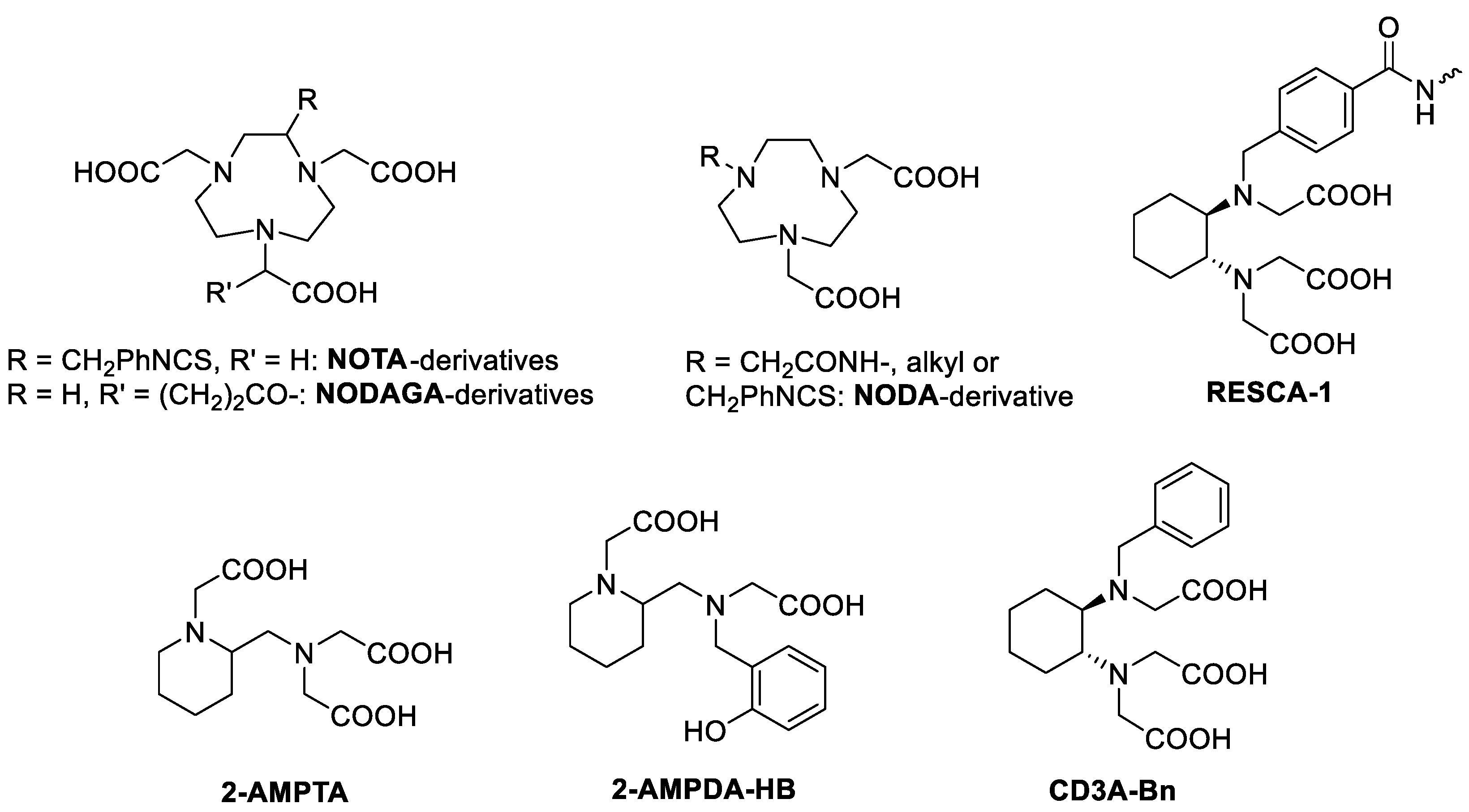
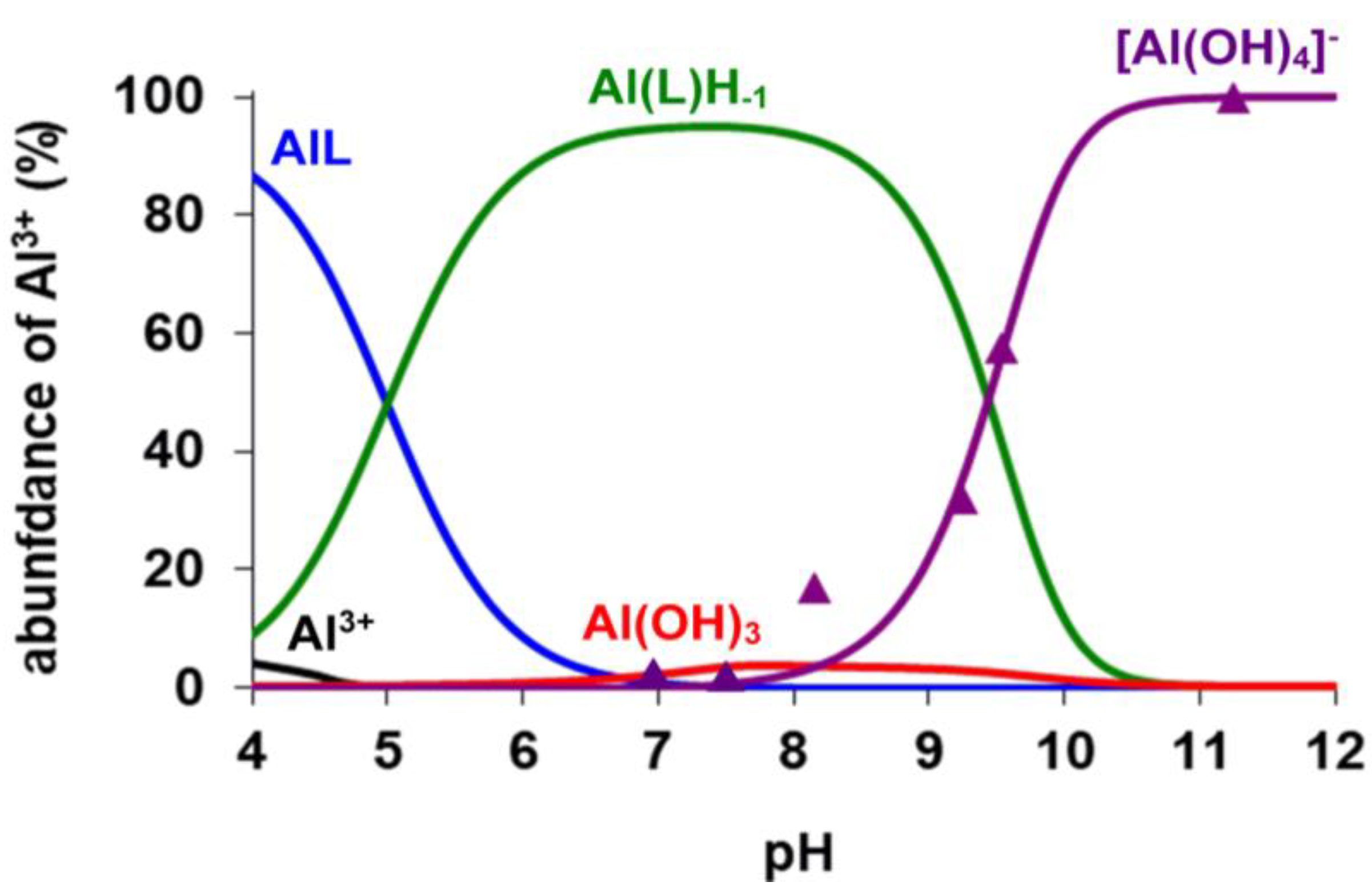
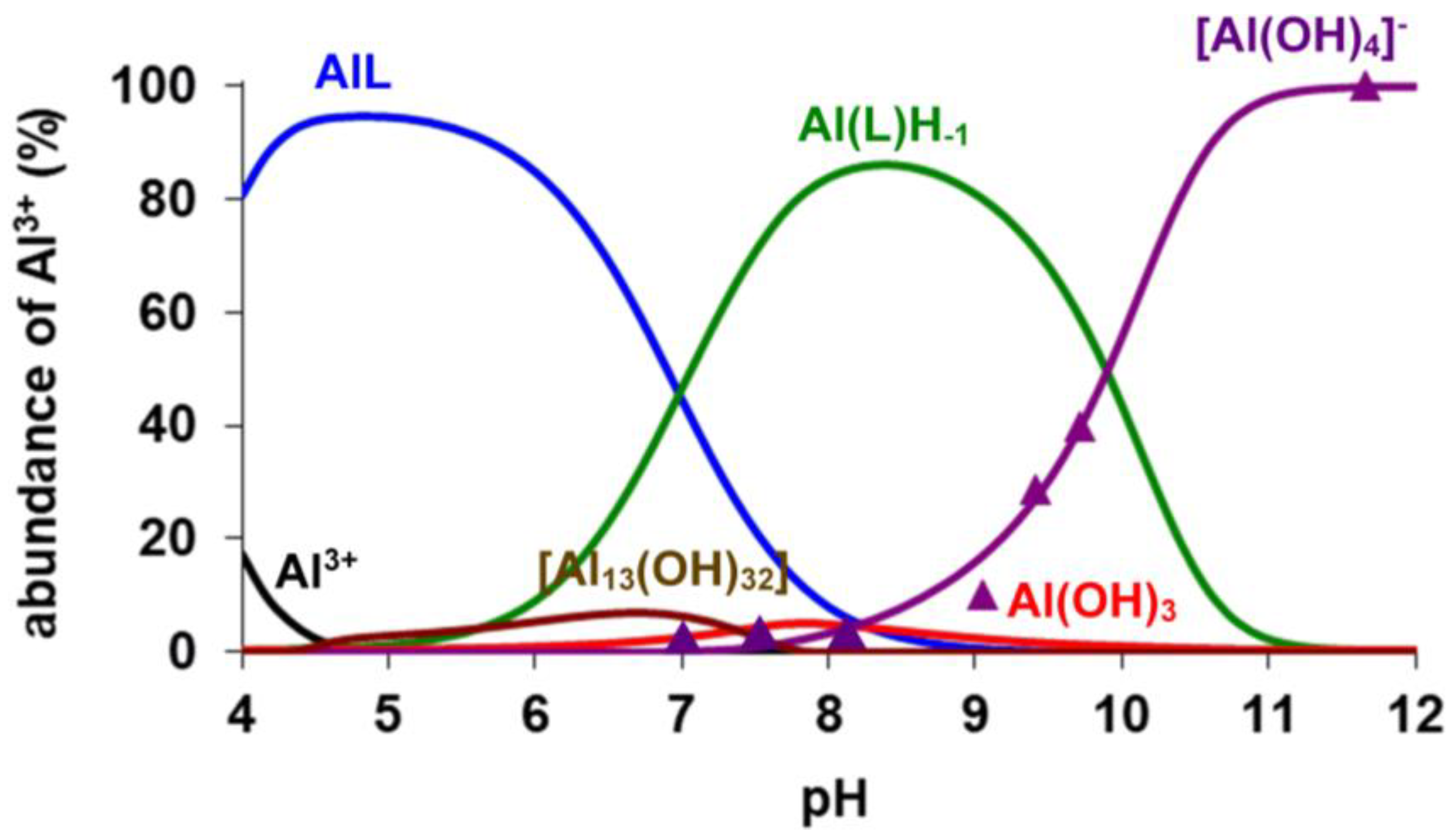
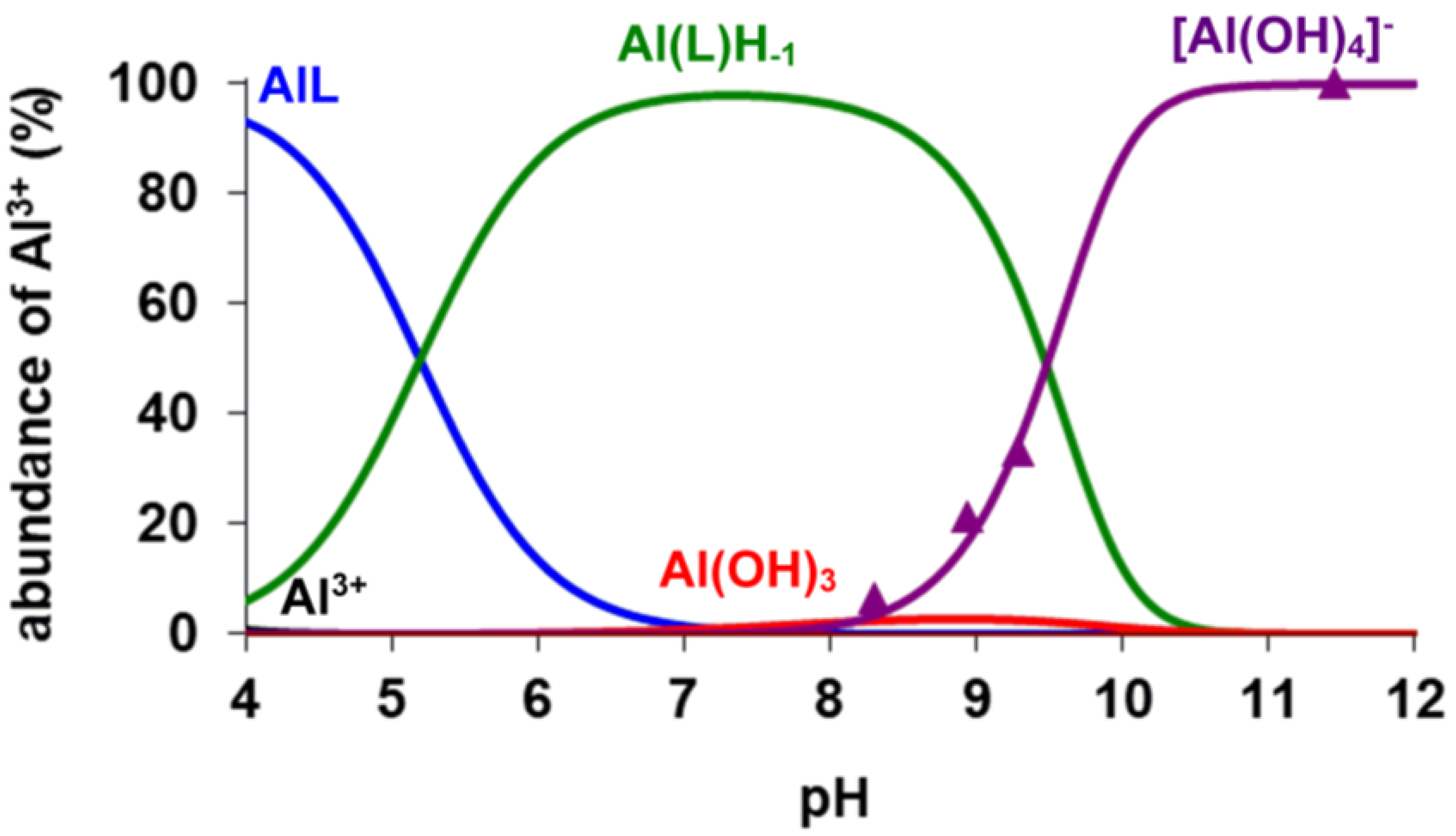
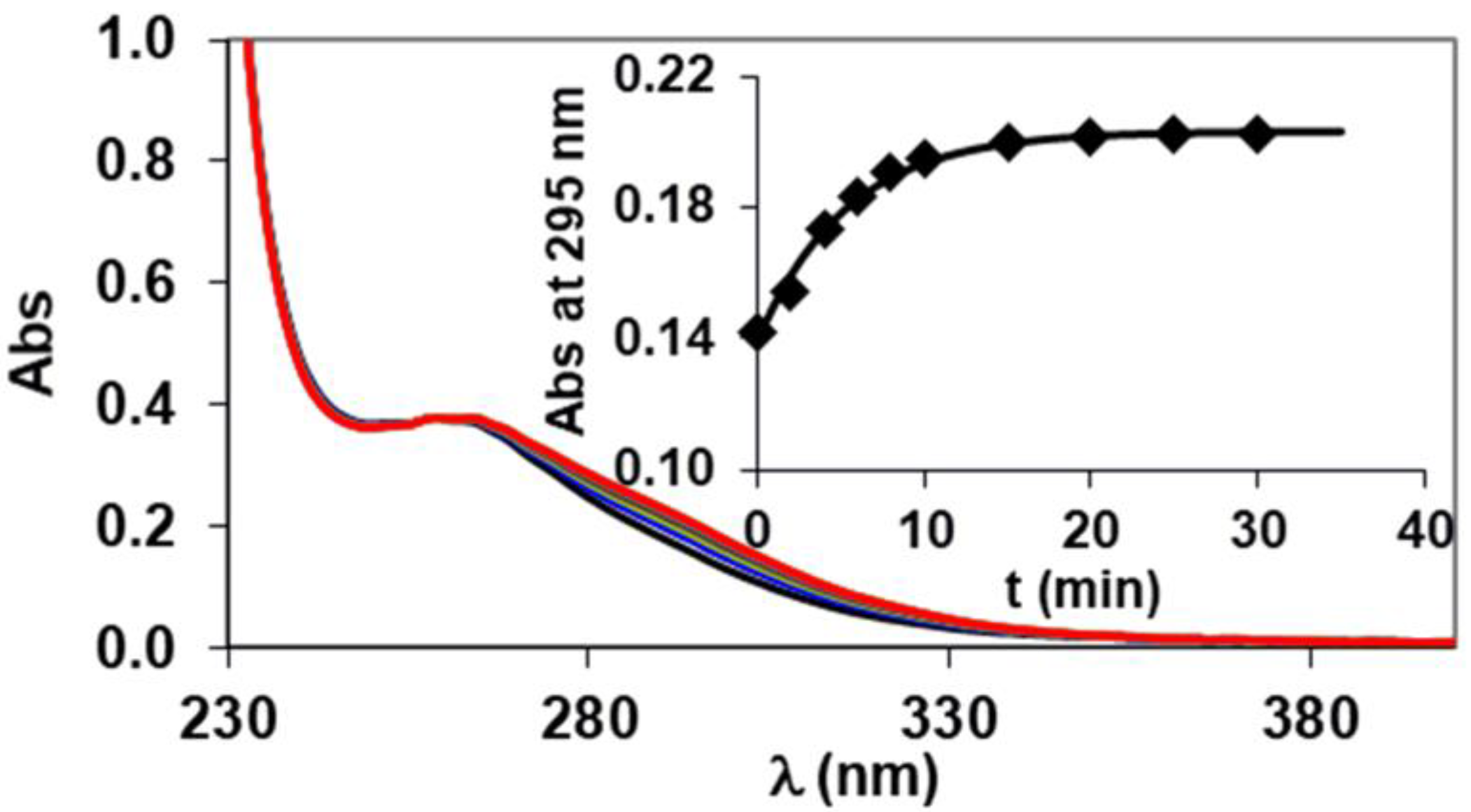
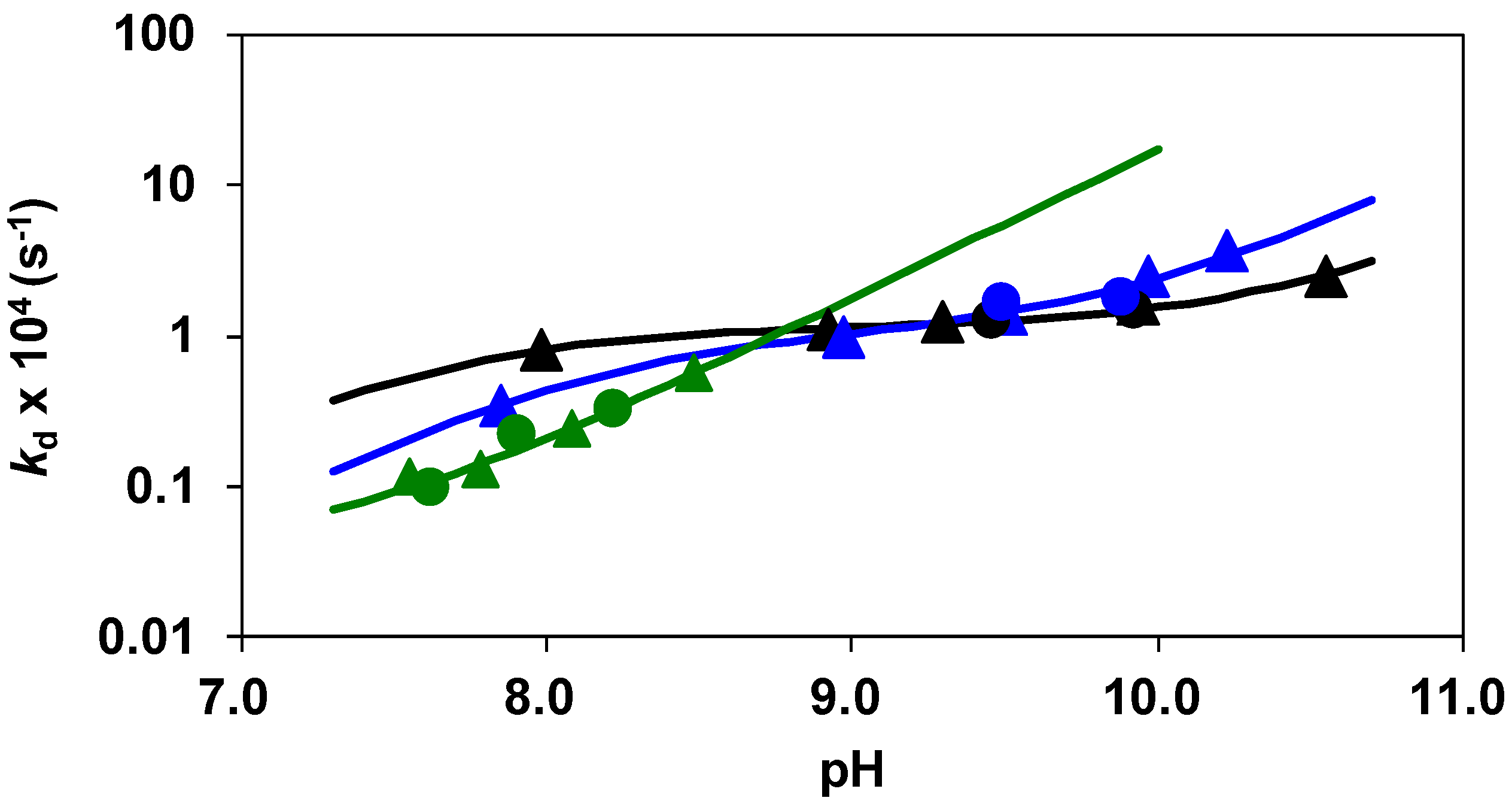

| [Al(AMPTA)] | [Al(AMPDA-HB)] | [Al(CD3A-Bn)] | [Al(NOTA)] a | |
|---|---|---|---|---|
| I | 0.15 M NaCl | 1.0 M NaCl | ||
| k0/s−1 | - | - | (4 ± 1) × 10−6 | 2 × 10−6 |
| k1/M−1 s−1 | 164 ± 20 | 43 ± 5 | 11 ± 1 | 6.8 × 10−6 b |
| k2/M−2 s−1 | (3.4 ± 0.6) × 105 | (4 ± 1) × 105 | - | - |
| KAl(L)H−2/M−1 | (1.0 ± 0.2) × 108 | (3.2 ± 0.4) × 108 | - | 1.6 × 1012 c |
| logKAl(L)H−2 | 8.0 (1) | 8.5 (1) | - | 12.2 |
| kd/s−1 (pH = 7.4) | 4.3 × 10−5 | 1.6 × 10−5 | 8.0 × 10−6 | 2 × 10−6 |
| t1/2/h (pH = 7.4) | 4.5 | 12.4 | 24.1 | 94 |
Disclaimer/Publisher’s Note: The statements, opinions and data contained in all publications are solely those of the individual author(s) and contributor(s) and not of MDPI and/or the editor(s). MDPI and/or the editor(s) disclaim responsibility for any injury to people or property resulting from any ideas, methods, instructions or products referred to in the content. |
© 2023 by the authors. Licensee MDPI, Basel, Switzerland. This article is an open access article distributed under the terms and conditions of the Creative Commons Attribution (CC BY) license (https://creativecommons.org/licenses/by/4.0/).
Share and Cite
Callegari, E.; Martinelli, J.; Guidolin, N.; Boccalon, M.; Baranyai, Z.; Tei, L. Thermodynamic and Kinetic Stabilities of Al(III) Complexes with N2O3 Pentadentate Ligands. Molecules 2023, 28, 3764. https://doi.org/10.3390/molecules28093764
Callegari E, Martinelli J, Guidolin N, Boccalon M, Baranyai Z, Tei L. Thermodynamic and Kinetic Stabilities of Al(III) Complexes with N2O3 Pentadentate Ligands. Molecules. 2023; 28(9):3764. https://doi.org/10.3390/molecules28093764
Chicago/Turabian StyleCallegari, Edoardo, Jonathan Martinelli, Nicol Guidolin, Mariangela Boccalon, Zsolt Baranyai, and Lorenzo Tei. 2023. "Thermodynamic and Kinetic Stabilities of Al(III) Complexes with N2O3 Pentadentate Ligands" Molecules 28, no. 9: 3764. https://doi.org/10.3390/molecules28093764
APA StyleCallegari, E., Martinelli, J., Guidolin, N., Boccalon, M., Baranyai, Z., & Tei, L. (2023). Thermodynamic and Kinetic Stabilities of Al(III) Complexes with N2O3 Pentadentate Ligands. Molecules, 28(9), 3764. https://doi.org/10.3390/molecules28093764






